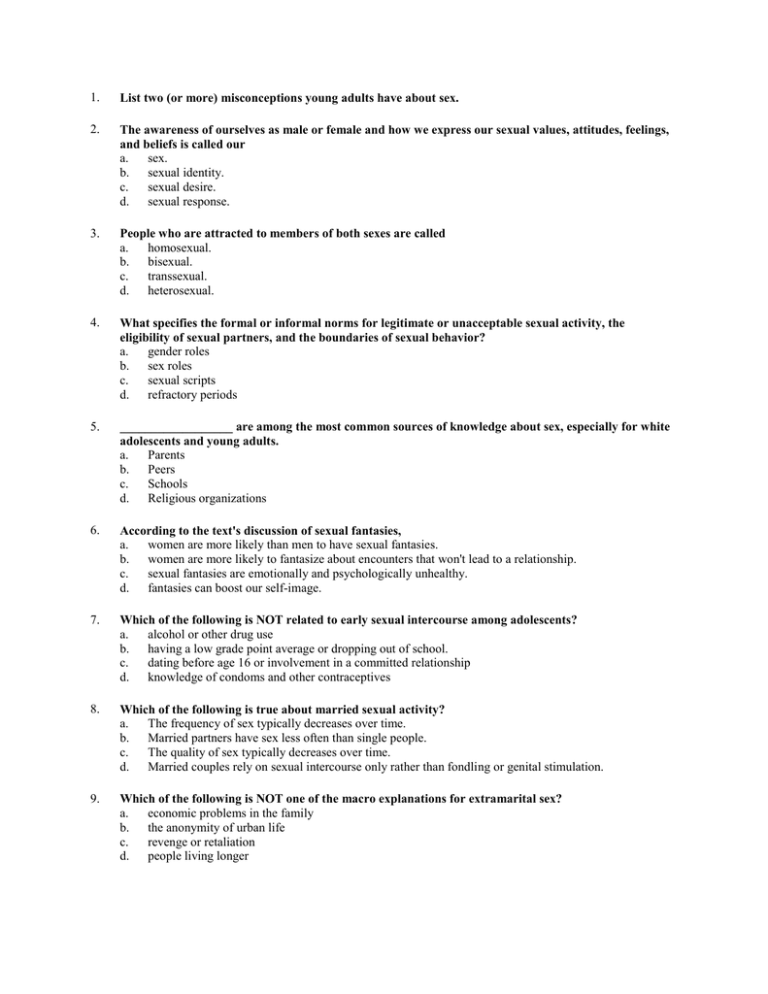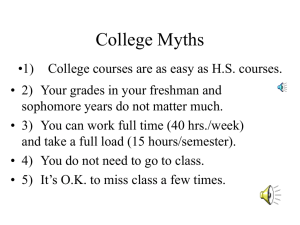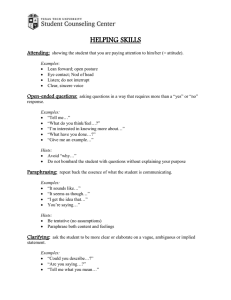
1.
List two (or more) misconceptions young adults have about sex.
2.
The awareness of ourselves as male or female and how we express our sexual values, attitudes, feelings,
and beliefs is called our
a.
sex.
b. sexual identity.
c.
sexual desire.
d. sexual response.
3.
People who are attracted to members of both sexes are called
a.
homosexual.
b. bisexual.
c.
transsexual.
d. heterosexual.
4.
What specifies the formal or informal norms for legitimate or unacceptable sexual activity, the
eligibility of sexual partners, and the boundaries of sexual behavior?
a.
gender roles
b. sex roles
c.
sexual scripts
d. refractory periods
5.
__________________ are among the most common sources of knowledge about sex, especially for white
adolescents and young adults.
a.
Parents
b. Peers
c.
Schools
d. Religious organizations
6.
According to the text's discussion of sexual fantasies,
a.
women are more likely than men to have sexual fantasies.
b. women are more likely to fantasize about encounters that won't lead to a relationship.
c.
sexual fantasies are emotionally and psychologically unhealthy.
d. fantasies can boost our self-image.
7.
Which of the following is NOT related to early sexual intercourse among adolescents?
a.
alcohol or other drug use
b. having a low grade point average or dropping out of school.
c.
dating before age 16 or involvement in a committed relationship
d. knowledge of condoms and other contraceptives
8.
Which of the following is true about married sexual activity?
a.
The frequency of sex typically decreases over time.
b. Married partners have sex less often than single people.
c.
The quality of sex typically decreases over time.
d. Married couples rely on sexual intercourse only rather than fondling or genital stimulation.
9.
Which of the following is NOT one of the macro explanations for extramarital sex?
a.
economic problems in the family
b. the anonymity of urban life
c.
revenge or retaliation
d. people living longer
10.
Which of the following is an accurate statement about STIs?
a.
Syphilis is the most common STI.
b. Nearly half of all STIs occur in people under age 25.
c.
Herpes and genital warts can be cured.
d. Most STIs cause noticeable symptoms.
11.
Describe three manifest functions that dating fulfills.
12.
In the twentieth century, people began to use the term "dating," which referred to
a.
a young man and woman walking home after church.
b. couples setting a specific date, time, and place to meet.
c.
a man visiting a woman at her parent's home.
d. a woman's mother inviting a young man to visit her daughter at their home.
13.
Which of the following is a latent function of dating?
a.
fun and recreation
b. companionship
c.
gaining social status
d. mate selection
14.
Which of the following is true concerning personal classified advertisements?
a.
They usually include comprehensive self-descriptions.
b. They are relatively expensive.
c.
They take a lot of time to set up.
d. They result in numerous responses.
15.
Which theory of mate-selection suggests that people searching for partners tend to go through a process
of sifting eligible people according to certain specific criteria, and thus narrowing the pool of potential
partners?
a.
complimentary needs theory
b. filter theory
c.
exchange theory
d. equity theory
16.
George, an upper-class, Baptist African American, married Giselle, a middle-class, Catholic Latina.
Their marriage is an example of
a.
homogamy.
b. heterogamy.
c.
endogamy.
d. interfaith relationships.
17.
In arranged marriages, __________ is more important than __________.
a.
the dowry; the age of the couple
b. the family or community; the individual
c.
love; customs
d. religion; wealth.
18.
Dave makes less money than Amy and also loves Amy more than she loves him. According to the
principle of least interest, Dave
a.
is most likely to leave the relationship.
b. is more likely to try to maintain the relationship.
c.
is less dependent on the relationship.
d. is taking advantage of Amy.
19.
__________ refers to unwanted, forced sexual intercourse in the context of a dating situation.
a.
Stranger rape
b. Acquaintance rape
c.
Date rape
d. Single rape
20.
A common reactions to breaking up is
a.
violence.
b. confusion and anger.
c.
a feeling of relief.
d. happiness.
21.
Describe three manifest functions that dating fulfills.
22.
In the twentieth century, people began to use the term "dating," which referred to
a.
a young man and woman walking home after church.
b. couples setting a specific date, time, and place to meet.
c.
a man visiting a woman at her parent's home.
d. a woman's mother inviting a young man to visit her daughter at their home.
23.
Which of the following is a latent function of dating?
a.
fun and recreation
b. companionship
c.
gaining social status
d. mate selection
24.
Which of the following is true concerning personal classified advertisements?
a.
They usually include comprehensive self-descriptions.
b. They are relatively expensive.
c.
They take a lot of time to set up.
d. They result in numerous responses.
25.
Which theory of mate-selection suggests that people searching for partners tend to go through a process
of sifting eligible people according to certain specific criteria, and thus narrowing the pool of potential
partners?
a.
complimentary needs theory
b. filter theory
c.
exchange theory
d. equity theory
26.
George, an upper-class, Baptist African American, married Giselle, a middle-class, Catholic Latina.
Their marriage is an example of
a.
homogamy.
b. heterogamy.
c.
endogamy.
d. interfaith relationships.
27.
In arranged marriages, __________ is more important than __________.
a.
the dowry; the age of the couple
b. the family or community; the individual
c.
love; customs
d. religion; wealth.
28.
Dave makes less money than Amy and also loves Amy more than she loves him. According to the
principle of least interest, Dave
a.
is most likely to leave the relationship.
b. is more likely to try to maintain the relationship.
c.
is less dependent on the relationship.
d. is taking advantage of Amy.
29.
__________ refers to unwanted, forced sexual intercourse in the context of a dating situation.
a.
Stranger rape
b. Acquaintance rape
c.
Date rape
d. Single rape
30.
A common reactions to breaking up is
a.
violence.
b. confusion and anger.
c.
a feeling of relief.
d. happiness.
31.
Discuss two benefits of cohabitation.
32.
Which of the following is an accurate statement?
a.
Since 1970, the number of single people has decreased.
b. Since 1972, the proportion of adults who have never-married has decreased.
c.
Since 1960, the number of unmarried-couple households has grown.
d. Since 1970, the proportion of households consisting of one person living alone has decreased.
33.
__________ singles are primarily older, divorced, widowed, and never-married people who would like to
marry or remarry but haven't found a suitable mate and now accept their single status as permanent.
This group also includes singles who suffer from some physical or psychological impairment that limits
their success in the marriage market.
a.
Involuntary stable
b. Involuntary temporary
c.
Voluntary temporary
d. Voluntary stable
34.
The proportion of men to women in a country or a group is referred to as the
a.
sex ratio.
b. marriage squeeze.
c.
demographic slide.
d. marriage opportunity index.
35.
Which of the following is a popular myth about being single?
a.
Singles are selfish and self-centered.
b. Singles make more time for friends and community service.
c.
More singles than marrieds live at or below poverty level.
d. Singles are too dependent on their families.
36.
In which type of cohabitation are couples testing the relationship before making a final commitment?
a.
premarital cohabitation
b. substitute marriage cohabitation
c.
dating cohabitation
d. trial marriage cohabitation
37.
The __________ effect refers to the fact that people who cohabit before marriage have different
characteristics than people who do not.
a.
cohabitation experience
b. selection
c.
inertia
d. dissolution
38.
Generally people who live together before marriage have _________ divorce rates than those who do not
live together before marriage.
a.
lower
b. similar
c.
equivalent
d. higher
39.
Which of the following is true about same-unions?
a.
Massachusetts is the only state that has legalized same-sex marriage.
b. A majority of Americans support same-sex civil unions but oppose same sex-marriage.
c.
Same-sex marriages are recognized in most countries around the world.
d. Civil unions confer the same rights to couples as an actual marriage.
40.
Collective households in which children and adults from different families live together are called
a.
apartments.
b. dormitories.
c.
communes.
d. camps.
Test Name: Quick Quiz 7-9
1.
One: Most believe that birth control methods other than condoms provide "safe sex." Two: Many do not know
the at STIs can cause some kinds of cancer. Three: Many do not know that one in four sexually active people
under 25 will get an STI during the year. Four: Many believe that oral sex cannot transmit STIs. Five: Quite a
few believe that pulling out the penis before ejaculation is "safe sex."
Feedback:
Hints:
2.
b. sexual identity.
Feedback:
Hints:
3.
b. bisexual.
Feedback:
Hints:
4.
c. sexual scripts
Feedback:
Hints:
5.
b. Peers
Feedback:
Hints:
6.
d. fantasies can boost our self-image.
Feedback:
Hints:
7.
d. knowledge of condoms and other contraceptives
Feedback:
Hints:
8.
a. The frequency of sex typically decreases over time.
Feedback:
Hints:
9.
c. revenge or retaliation
Feedback:
Hints:
10.
b. Nearly half of all STIs occur in people under age 25.
Feedback:
Hints:
11.
Manifest functions: maturation, fun and recreation, companionship, love and affection, mate selection
Feedback:
Hints:
12.
b. couples setting a specific date, time, and place to meet.
Feedback:
Hints:
13.
c. gaining social status
Feedback:
Hints:
14.
d. They result in numerous responses.
Feedback:
Hints:
15.
b. filter theory
Feedback:
Hints:
16.
b. heterogamy.
Feedback:
Hints:
17.
b. the family or community; the individual
Feedback:
Hints:
18.
b. is more likely to try to maintain the relationship.
Feedback:
Hints:
19.
c. Date rape
Feedback:
Hints:
20.
b. confusion and anger.
Feedback:
Hints:
21.
Manifest functions: maturation, fun and recreation, companionship, love and affection, mate selection
Feedback:
Hints:
22.
b. couples setting a specific date, time, and place to meet.
Feedback:
Hints:
23.
c. gaining social status
Feedback:
Hints:
24.
d. They result in numerous responses.
Feedback:
Hints:
25.
b. filter theory
Feedback:
Hints:
26.
b. heterogamy.
Feedback:
Hints:
27.
b. the family or community; the individual
Feedback:
Hints:
28.
b. is more likely to try to maintain the relationship.
Feedback:
Hints:
29.
c. Date rape
Feedback:
Hints:
30.
b. confusion and anger.
Feedback:
Hints:
31.
1) couples have the emotional security of an intimate relationship but can also maintain their independence; 2)
couples can leave the relationship more easily; 3) couples who postpone marriage have a lower likelihood of
divorce; 4) cohabitation can help people find out how much they really care about each other when they have
to cope with the unpleasant realities of living together; 5) among people age 65 and older, cohabitation may
increase the chances of receiving care that is usually provided by spouses; 6) cohabitants do not have to deal
with in-laws; 7) children can reap some benefits by living with two adult earners instead of a single mother.
Feedback:
Hints:
32.
c. Since 1960, the number of unmarried-couple households has grown.
Feedback:
Hints:
33.
a. Involuntary stable
Feedback:
Hints:
34.
a. sex ratio.
Feedback:
Hints:
35.
a. Singles are selfish and self-centered.
Feedback:
Hints:
36.
a. premarital cohabitation
Feedback:
Hints:
37.
b. selection
Feedback:
Hints:
38.
d. higher
Feedback:
Hints:
39.
b. A majority of Americans support same-sex civil unions but oppose same sex-marriage.
Feedback:
Hints:
40.
c. communes.
Feedback:
Hints:





